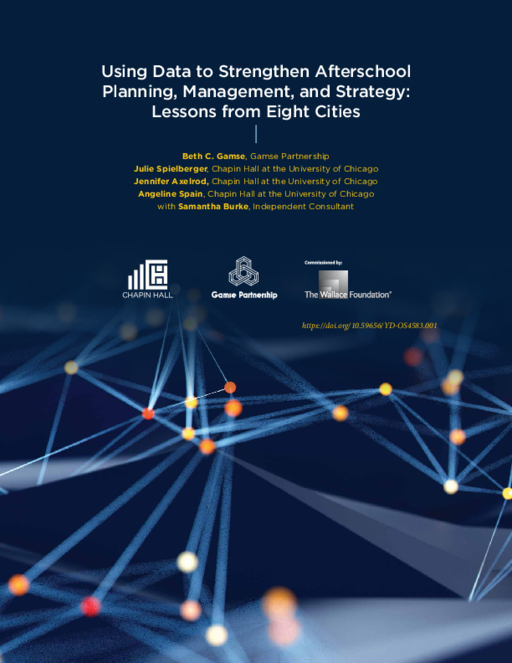- Author(s)
- Beth C. Gamse, Julie Spielberger, Jennifer Axelrod, Angeline Spain, and Samantha Burke
- Publisher(s)
- Chapin Hall at the University of Chicago and Gamse Partnership
Research Approach
Information for the two reports in this series was drawn from an analysis of city documents, site visits, and interviews with key stakeholders, observations of selected trainings and meetings related to data use, and attendance at three, cross-city grantee meetings in fall 2013, spring 2014, and fall 2014.
This report summarizes findings based on the entire duration of the initiative, focusing chiefly on cities’ progress by the end of 2016 when data collection activities were completed. It incorporates findings based on analyses of site visit and telephone interviews with system leaders, key partners, and providers, observations of selected trainings and meetings related to data use, and the review of city-specific documents and reports. It summarizes how the funded cities approached afterschool data system building, how they operated their data systems, and how they used the data collected to improve their afterschool systems.
From the earlier report: The researchers conducted in-person site visits with each of the nine cities participating in Wallace's Next Generation Initiative during the winter and spring of 2014 to interview key stakeholders and observe selected meetings related to the development of data systems and use of data. Across the cities, 104 interviews were conducted (an average of 11–12 per city) and 13 meetings were observed. Stakeholders represented a range of organizations and roles, including system-level leadership and managers in the afterschool community.
The researchers used similar data collection and analysis approaches across the cities. The initial tasks were to establish a baseline understanding of each of the afterschool systems and the context in which each system was developing, document the individuals and organizations involved, catalog planned and in-progress activities, and capture the goals for data use for each system.
The team used multiple sources of information, including literature on data use in the afterschool field and in education and other fields, early documents and observations from each of the participating cities, telephone and in-person interviews, and on-site observations of selected meetings. To organize and guide the analysis, they developed a conceptual framework that includes the people, processes, and technology involved in collecting and using data within an afterschool system. They developed semi structured interview guides based on their literature reviews and their initial conceptual framework of a data system. They also included questions about the characteristics and policy context to understand the broader setting of the afterschool systems.


